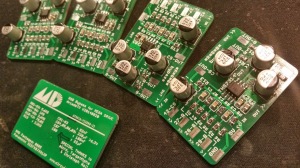News, Retrogaming news
RGB Bypass for picture perfection
 Today we learnt of an exciting development from German videogame enthusiast ArcadeTV (@arcadetv on Twitter). Their new “RGB Bypass” modifications for Neo Geo, Megadrive/Genesis and Sega Master System promises to take the picture quality from these systems to the next level. At first glance the name of these mods may confuse you. Why would you want to bypass RGB, when it is the best signal available for older games consoles? The ‘bypass’ in the name of these particular mods refers to the RGB encoder chips. In the case of the Megadrive for instance, the mod takes and encodes RGB directly from the machines VDP (graphics chip) and bypasses the old CXA-1145 RGB encoder which is known to add the “jail bar” effect to the picture on many consoles.
Today we learnt of an exciting development from German videogame enthusiast ArcadeTV (@arcadetv on Twitter). Their new “RGB Bypass” modifications for Neo Geo, Megadrive/Genesis and Sega Master System promises to take the picture quality from these systems to the next level. At first glance the name of these mods may confuse you. Why would you want to bypass RGB, when it is the best signal available for older games consoles? The ‘bypass’ in the name of these particular mods refers to the RGB encoder chips. In the case of the Megadrive for instance, the mod takes and encodes RGB directly from the machines VDP (graphics chip) and bypasses the old CXA-1145 RGB encoder which is known to add the “jail bar” effect to the picture on many consoles.
Early indications are that the results for all the bypass modifications are nothing short of stunning. We’ve been in contact with ArcadeTV and hope to source a Megadrive RGB Bypass modification for review in the near future. ArcadeTV also told us that English speaking customers will be able to purchase the mods through our friends over at RetroRGB soon.
Update – Alex (@ArcadeTV) has been in touch with more technical details on the mod for those of you that are interested.
I’d like to share some more insight. I’m Alex and I go by the nick ArcadeTV because my passion has always been arcade related stuff and retro videogame consoles on crt televisions. I did not re-invent the wheel here but I think that this whole bypassing thing is a great benefit for anyone who wants the best possible picture quality off their console. I only did the bypass PCBs for Mega Drive and Neo Geo AES, Master System is next. PC Engine and SNES were already done by others. PC Engine is a different Story because there is no RGB-Encoder in that system that could be bypassed, on PCE the THS7413 amplifier chip was used to get the best possible picture quality and I re-used this setup for my bypass-mods.
Also noteworthy is that it is not the CXA1145P that is responsible for jailbars, but it’s the clock-signals (e.g. subcarrier and VRAM pulses) that interfer with its output.
So, here’s the story behind the mods: I’m not a technician, but I tend to gather enough know-how to modify and repair those old machines. Recently I got an oscilloscope and went straight into the modding business with it 😉 Let’s have a closer look at the Mega Drive… the R,G,B and Csync signals are generated from the VDP chip. From here their levels get lowered to a suitable level for the CXA’s input and then they go right to the video output. If you want to use a THS7314 (which is a much more modern IC and has better filters) you need to adjust the levels of the RGB signals down to what the IC can handle, that’s 0.7Vpp, so we need to build a new voltage devider. You can only measure the peak to peak voltage from the VDP while the console is displaying a pure white screen, on Mega Drive the 240p Test Suite is great for that, on Neo Geo you need a unibios and power the system on without a cartridge inserted. For the Master System I now have a little homebrew for this job.
After the signals pass the THS and are terminated by 75Ohm resistors in series those build another voltage divider insider your tv (pretty much all TVs have 75Ohms to GND on their connectors) – and there you have it: 0.7Vpp on the input of the THS, 1.4Vpp on the Output and again 0.7Vpp when the RGB hits the television. Based on measuring and calculations.
I’ll try to setup something for the english-speaking people but right now I really lack the time for that so just follow me on Twitter or get in touch. You can usually find me here, cheers.


Also the picture with the PCBs is a bit misleading and looks like if I’m going to mass-produce these PCBs to sell them. I have no financial interest and the information to do the mod is freely available to anyone.
Schematic is here
So are you saying quantities will be limited? That would be a shame I was hoping they would be readily available soon.
btw @buckoA51, circuit-board.de is not MY forum… it’s just a place where I hang out and post my stuff usually 😉
OK, corrected!
The vertical white bar on the snes is a different story! It’s mostly visible on 1CHIP consoles. The bypass method mentioned over at retroRGB is one way to get rid of it. The other is to replace that big 2200uF capacitor plus three 220uF: one on the output of the 7805 and the two remaining on the supply-pins of the S-RGB IC.
I wonder if this would also fix the SNES’ white bar? Anything been stated on that?
White bar?
http://www.joeredifer.com/crap/snesline.jpg
Comment moved to main article body.